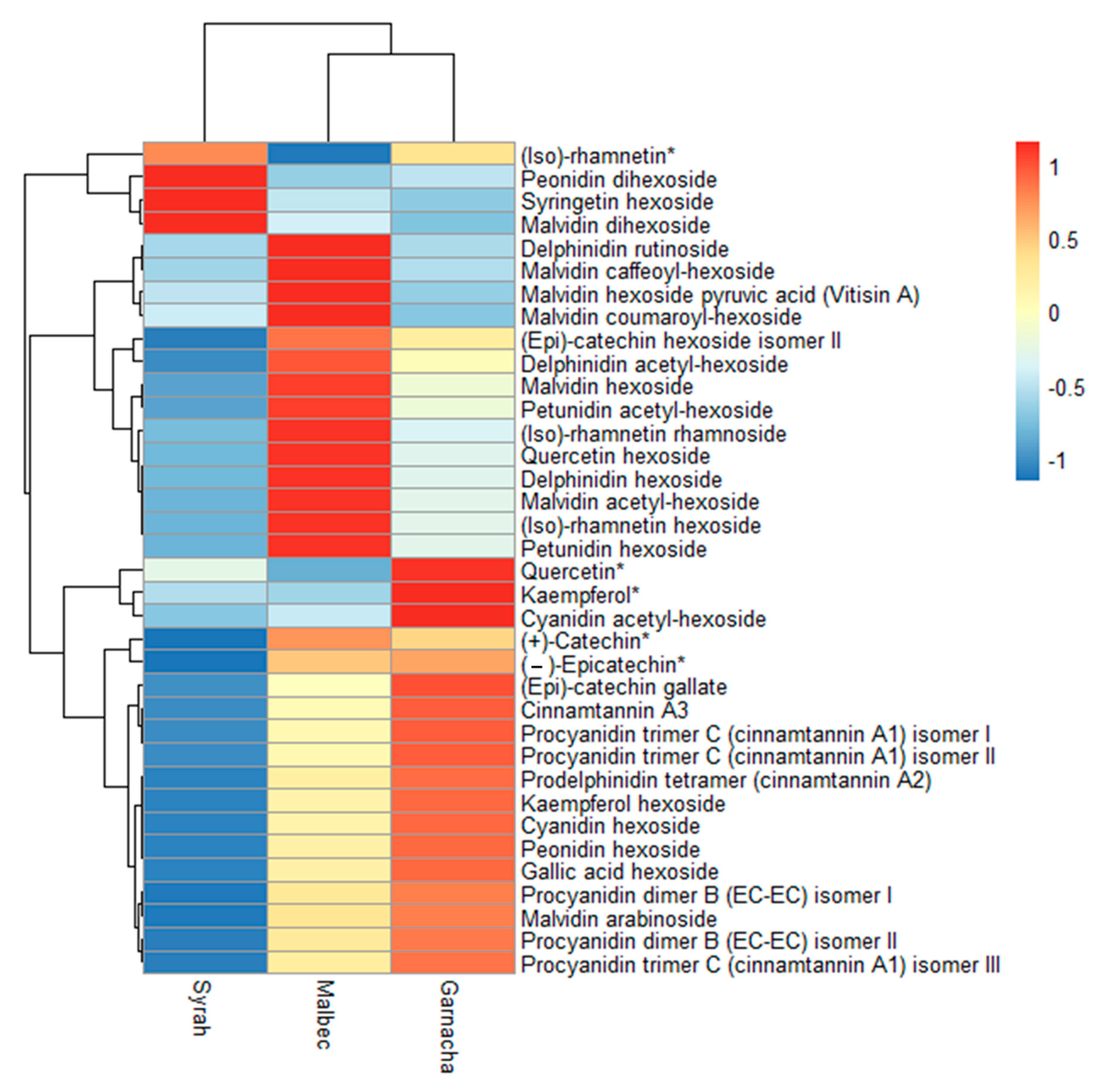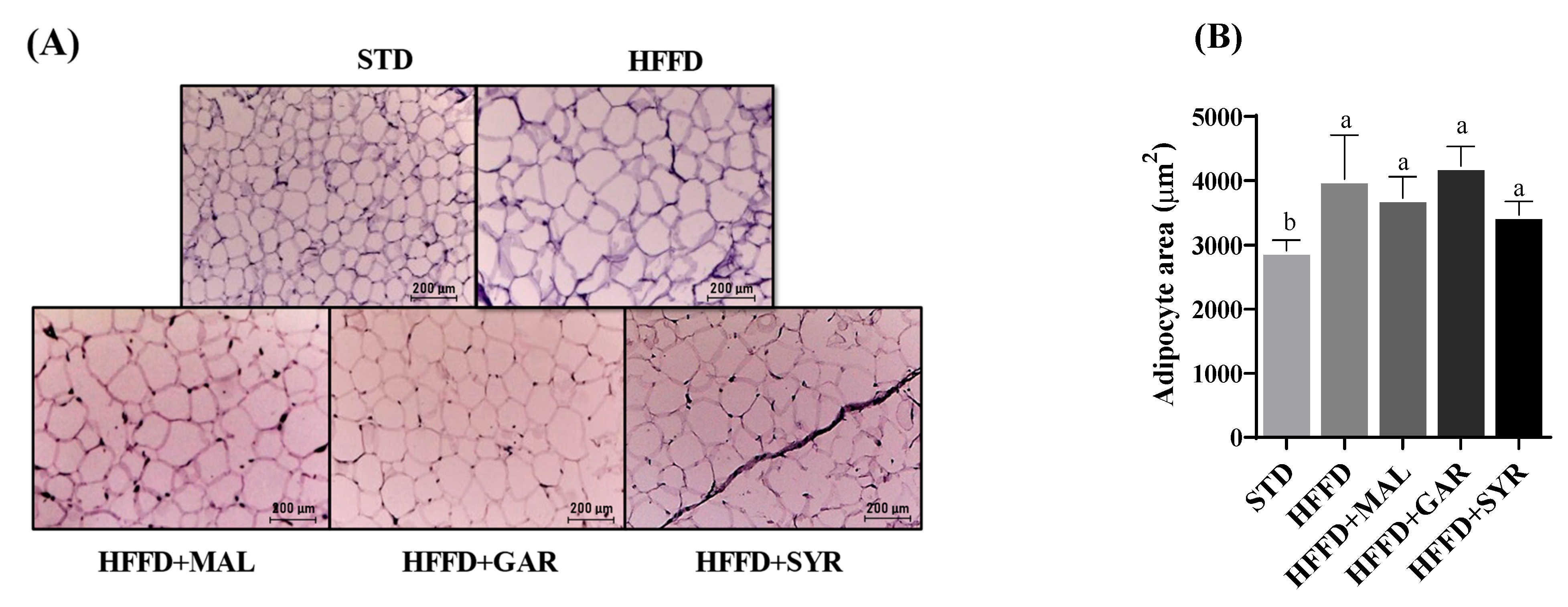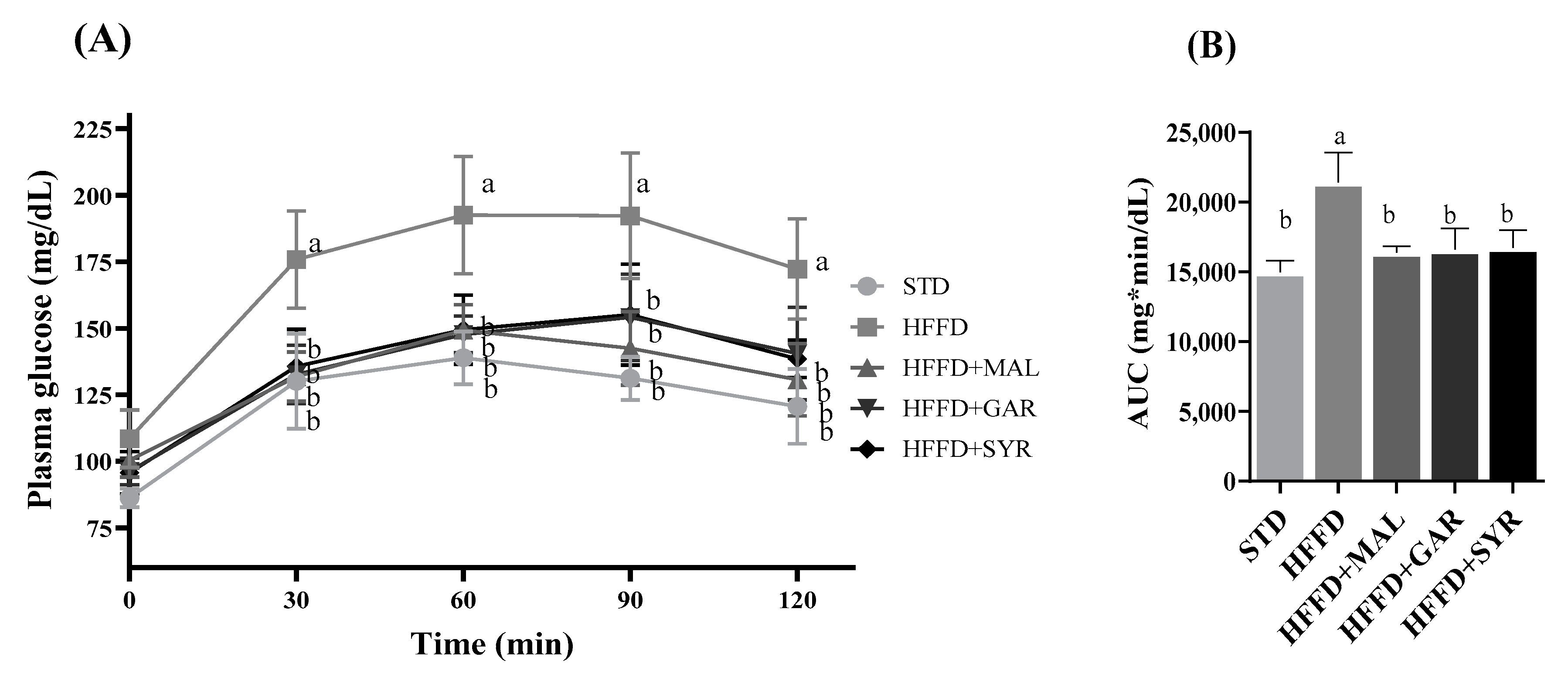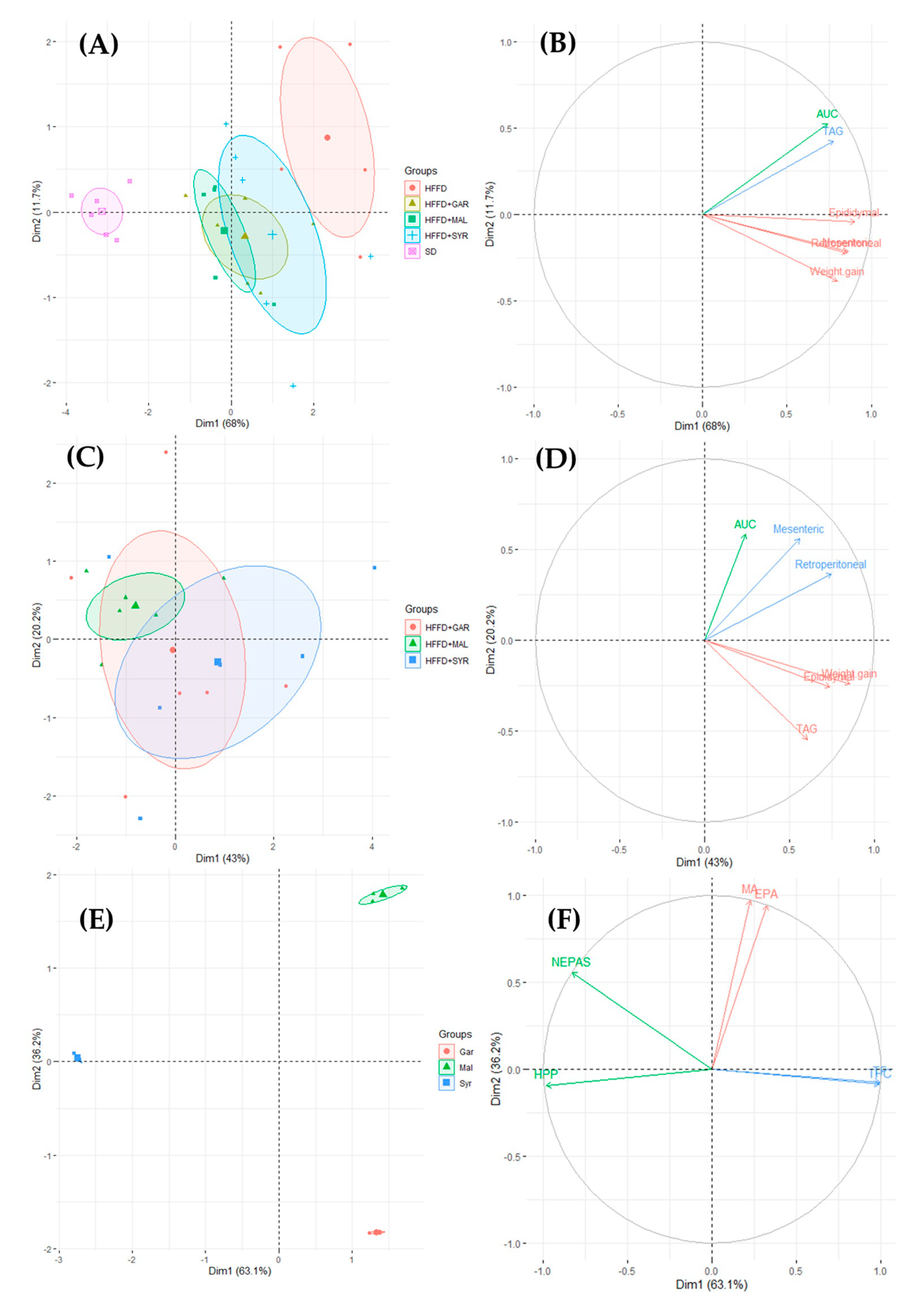Three Varieties of Grape Pomace, with Distinctive Extractable:Non-Extractable Polyphenol Ratios, Differentially Reduce Obesity and Its Complications in Rats Fed a High-Fat High-Fructose Diet
Abstract
1. Introduction
2. Materials and Methods
2.1. Raw Material
2.2. Polyphenol Analysis
2.2.1. Total Extractable Polyphenols
2.2.2. Total Non-Extractable Polyphenols
2.2.3. Profile of Extractable Polyphenols
2.3. In Vivo Effects of Grape Pomaces
2.3.1. Food and Energy Intake
2.3.2. OGTT Assay
2.3.3. Animal Slaughter
2.3.4. Histology Analysis of Mesenteric Adipose Tissue
2.3.5. Quantification of Serum Lipids
2.4. Statistical Analysis
3. Results
3.1. Grape Pomace Characterization
3.2. In Vivo Effects of Grape Pomace Supplementation
3.3. Integrative Approach to the In Vivo Effects of Grape Pomace Supplementation
4. Discussion
5. Conclusions
Supplementary Materials
Author Contributions
Funding
Data Availability Statement
Acknowledgments
Conflicts of Interest
References
- Peixoto, C.M.; Dias, M.I.; Alves, M.J.; Calhelha, R.C.; Barros, L.; Pinho, S.P.; Ferreira, I.C. Grape pomace as a source of phenolic compounds and diverse bioactive properties. Food Chem. 2018, 253, 132–138. [Google Scholar] [CrossRef]
- Pérez-Jiménez, J.; Saura-Calixto, F. Fruit peels as sources of non-extractable polyphenols or macromolecular antioxidants: Analysis and nutritional implications. Food Res. Int. 2018, 111, 148–152. [Google Scholar] [CrossRef] [PubMed]
- Martins, C.C.; Rodrigues, R.C.; Mercali, G.D.; Rodrigues, E. New insights into non-extractable phenolic compounds analysis. Food Res. Int. 2022, 157, 111487. [Google Scholar] [CrossRef] [PubMed]
- Beres, C.; Costa, G.N.; Cabezudo, I.; da Silva-James, N.K.; Teles, A.S.; Cruz, A.P.; Mellinger-Silva, C.; Tonon, R.V.; Cabral, L.M.C.; Freitas, S.P. Towards integral utilization of grape pomace from winemaking process: A review. Waste Manag. 2017, 68, 581–594. [Google Scholar] [CrossRef] [PubMed]
- Kopp, W. How western diet and lifestyle drive the pandemic of obesity and civilization diseases. Diabetes Metab. Syndr. Obes. 2019, 12, 2221–2236. [Google Scholar] [CrossRef]
- McNabney, S.M.; Henagan, T.M. Short chain fatty acids in the colon and peripheral tissues: A focus on butyrate, colon cancer, obesity and insulin resistance. Nutrients 2017, 9, 1348. [Google Scholar] [CrossRef]
- Raiko, J.; Holstila, M.; Virtanen, K.A.; Orava, J.; Saunavaara, V.; Niemi, T.; Laine, J.; Taittonen, M.; Borra, R.J.H.; Nuutila, P.; et al. Brown adipose tissue triglyceride content is associated with decreased insulin sensitivity, independently of age and obesity. Diabetes Obes. Metab. 2015, 17, 516–519. [Google Scholar] [CrossRef]
- Heidker, R.M.; Caiozzi, G.C.; Ricketts, M.L. Dietary procyanidins selectively modulate intestinal farnesoid X receptor-regulated gene expression to alter enterohepatic bile acid recirculation: Elucidation of a novel mechanism to reduce triglyceridemia. Mol. Nutr. Food Res. 2015, 60, 727–736. [Google Scholar] [CrossRef]
- Russo, B.; Picconi, F.; Malandrucco, I.; Frontoni, S. Flavonoids and insulin-resistance: From molecular evidences to clinical trials. Intl. J. Mol. Sci. 2019, 20, 2061. [Google Scholar] [CrossRef]
- Van Hul, M.; Geurts, L.; Plovier, H.; Druart, C.; Everard, A.; Ståhlman, M.; Rhimi, M.; Chira, K.; Teissedre, P.-L.; Cani, P.D.; et al. Reduced obesity, diabetes, and steatosis upon cinnamon and grape pomace are associated with changes in gut microbiota and markers of gut barrier. Am. J. Physiol. Endocrinol. Metab. 2018, 314, E334–E352. [Google Scholar] [CrossRef]
- Lanzi, C.R.; Perdicaro, D.J.; Landa, M.S.; Fontana, A.; Antoniolli, A.; Miatello, R.M.; Oteiza, P.I.; Prieto, M.A.V. Grape pomace extract induced beige cells in white adipose tissue from rats and in 3T3-L1 adipocytes. J. Nutr. Biochem. 2016, 56, 224–233. [Google Scholar] [CrossRef]
- Ohyama, K.; Furuta, C.; Nogusa, Y.; Nomura, K.; Miwa, T.; Suzuki, K. Catechin-rich grape seed extract supplementation attenuates diet-induced obesity in C57BL/6J mice. Ann. Nutr. Metab. 2011, 58, 250–258. [Google Scholar] [CrossRef] [PubMed]
- Nie, Y.; Stürzenbaum, S.R. Proanthocyanidins of natural origin: Molecular mechanisms and implications for lipid disorder and aging-associated diseases. Adv. Nutr. 2019, 10, 464–478. [Google Scholar] [CrossRef] [PubMed]
- Hernández-Salinas, R.; Decap, V.; Leguina, A.; Cáceres, P.; Perez, D.; Urquiaga, I.; Iturriaga, R.; Velarde, V. Antioxidant and anti hyperglycemic role of wine grape powder in rats fed with a high fructose diet. Biol. Res. 2015, 48, 53. [Google Scholar] [CrossRef] [PubMed]
- Daniel, T.; Ben-Shachar, M.; Drori, E.; Hamad, S.; Permyakova, A.; Ben-Cnaan, E.; Tam, J.; Kerem, Z.; Rosenzweig, T. Grape pomace reduces the severity of non-alcoholic hepatic steatosis and the development of steatohepatitis by improving insulin sensitivity and reducing ectopic fat deposition in mice. J. Nutr. Biochem. 2021, 98, 108867. [Google Scholar] [CrossRef]
- Urquiaga, I.; D’Acuña, S.; Pérez, D.; Dicenta, S.; Echeverría, G.; Rigotti, A.; Leighton, F. Wine grape pomace flour improves blood pressure, fasting glucose and protein damage in humans: A randomized controlled trial. Biol. Res. 2015, 48, 49. [Google Scholar] [CrossRef]
- Martínez-Maqueda, D.; Zapatera, B.; Gallego-Narbón, A.; Vaquero, M.P.; Saura-Calixto, F.; Pérez-Jiménez, J. A 6-week supplementation with grape pomace to subjects at cardiometabolic risk ameliorates insulin sensitivity, without affecting other metabolic syndrome markers. Food Funct. 2018, 9, 6010–6019. [Google Scholar] [CrossRef]
- Pérez-Jiménez, J.; Díaz-Rubio, M.E.; Saura-Calixto, F. Non-extractable polyphenols, a major dietary antioxidant: Occurrence, metabolic fate and health effects. Nutr. Res. Rev. 2013, 26, 118–129. [Google Scholar] [CrossRef]
- Averilla, J.N.; Oh, J.; Kim, H.J.; Kim, J.S.; Kim, J.S. Potential health benefits of phenolic compounds in grape processing by-products. Food Sci. Biotechnol. 2019, 28, 1607–1615. [Google Scholar] [CrossRef]
- Pérez-Jiménez, J.; Arranz, S.; Tabernero, M.; Díaz-Rubio, M.E.; Serrano, J.; Goñi, I.; Saura-Calixto, F. Updated methodology to determine antioxidant capacity in plant foods, oils and beverages: Extraction, measurement and expression of results. Food Res. Int. 2008, 41, 274–285. [Google Scholar] [CrossRef]
- Ranjbar, N.; Eikani, M.H.; Javanmard, M.; Golmohammad, F. Impact of instant controlled pressure drop on phenolic compounds extraction from pomegranate peel. Innov. Food Sci. Emerg. Technol. 2016, 37, 177–183. [Google Scholar] [CrossRef]
- Heimler, D.; Vignolini, P.; Dini, M.G.; Vincieri, F.F.; Romani, A. Antiradical activity and polyphenol composition of local Brassicaceae edible varieties. Food Chem. 2006, 99, 464–469. [Google Scholar] [CrossRef]
- Giusti, M.M.; Wrolstad, R.E. Characterization and measurement of anthocyanins by UV-visible spectroscopy. Curr. Protoc. Food Anal. Chem. 2001, F1.2.1–F1.2.13. [Google Scholar] [CrossRef]
- Zurita, J.; Díaz-Rubio, M.E.; Saura-Calixto, F. Improved procedure to determine non-extractable polymeric proanthocyanidins in plant foods. Int. J. Food Sci. Nutr. 2012, 63, 936–993. [Google Scholar] [CrossRef] [PubMed]
- Hartzfeld, P.W.; Forkner, R.; Hunter, M.D.; Hagerman, A.E. Determination of hydrolyzable tannins (gallotannins and ellagitannins) after reaction with potassium iodate. J. Agric. Food Chem. 2002, 50, 1785–1790. [Google Scholar] [CrossRef] [PubMed]
- Martínez-Meza, Y.; Pérez-Jiménez, J.; Castaño-Tostado, E.; Pérez-Ramírez, I.; Alonzo-Macías, M.; Reynoso-Camacho, R. Instant controlled pressure drop as strategy for modifying extractable and non-extractable phenolic compounds ratio: A study in different grape pomace materials. J. Agric. Food Chem. 2021, 70, 6911–6921. [Google Scholar] [CrossRef]
- Milinčić, D.D.; Kostić, A.Ž.; Špirović-Trifunović, B.D.; Tešić, Ž.L.; Tosti, T.B.; Dramićanin, A.M.; Barać, M.B.; Pešić, M.B. Grape seed flour of different grape pomaces: Fatty acid profile, soluble sugar profile and nutritional value. J. Serb. Chem. Soc. 2020, 85, 305–319. [Google Scholar] [CrossRef]
- Spinei, M.; Oroian, M. The potential of grape pomace varieties as a dietary source of pectic substances. Foods 2021, 10, 867. [Google Scholar] [CrossRef]
- Ruberto, G.; Renda, A.; Daquino, C.; Amico, V.; Spatafora, C.; Tringali, C.; De Tommasi, N. Polyphenol constituents and antioxidant activity of grape pomace extracts from five Sicilian red grape cultivars. Food Chem. 2007, 100, 203–210. [Google Scholar] [CrossRef]
- Sagdic, O.; Ozturk, I.; Yilmaz, M.T.; Yetim, H. Effect of grape pomace extracts obtained from different grape varieties on microbial quality of beef patty. J. Food Sci. 2011, 76, M515–M521. [Google Scholar] [CrossRef]
- Arranz, S.; Silván, J.M.; Saura-Calixto, F. Nonextractable polyphenols, usually ignored, are the major part of dietary polyphenols: A study on the Spanish diet. Mol. Nutr. Food Res. 2010, 54, 1646–1658. [Google Scholar] [CrossRef] [PubMed]
- Pérez-Jiménez, J.; Arranz, S.; Saura-Calixto, F. Proanthocyanidin content in foods is largely underestimated in the literature data: An approach to quantification of the missing proanthocyanidins. Food Res. Int. 2009, 42, 1381–1388. [Google Scholar] [CrossRef]
- Du, H.; Wang, Q.; Li, T.; Ren, D.; Yang, X. Grape seed proanthocyanidins reduced the overweight of C57BL/6J mice through modulating adipose thermogenesis and gut microbiota. Food Funct. 2021, 12, 8467–8477. [Google Scholar] [CrossRef] [PubMed]
- Cho, S.J.; Jung, U.J.; Park, H.J.; Kim, H.J.; Park, Y.B.; Kim, S.R.; Choi, M.S. Combined ethanol extract of grape pomace and omija fruit ameliorates adipogenesis, hepatic steatosis, and inflammation in diet-induced obese mice. Evid. Based Complement. Alternat. Med. 2013, 2013, 212139. [Google Scholar] [CrossRef] [PubMed]
- Rosenzweig, T.; Skalka, N.; Rozenberg, K.; Elyasiyan, U.; Pinkus, A.; Green, B.; Stanevsky, M.; Drori, E. Red wine and wine pomace reduced the development of insulin resistance and liver steatosis in HFD-fed mice. J. Funct. Foods. 2017, 34, 379–389. [Google Scholar] [CrossRef]
- Lenquiste, S.A.; Lamas, C.A.; Marineli, R.S.; Moraes, E.A.; Borck, P.C.; Camargo, R.L.; Quitete, V.H.A.C.; Carneiro, E.M.; Maróstica, M.R. Jaboticaba peel powder and jaboticaba peel aqueous extract reduces obesity, insulin resistance and hepatic fat accumulation in rats. Food Res. Int. 2019, 120, 880–887. [Google Scholar] [CrossRef]
- da Costa, G.F.; Santos, I.B.; de Bem, G.F.; Cordeiro, V.S.C.; da Costa, C.A.; de Carvalho, L.C.R.M.; Ognibene, D.T.; Resende, A.C.; de Moura, R.S. The beneficial effect of anthocyanidin-rich Vitis vinifera L. grape skin extract on metabol-ic changes induced by high-fat diet in mice involves antiinflammatory and antioxidant actions. Phytother. Res. 2017, 31, 1621–1632. [Google Scholar] [CrossRef]





| MAL | GAR | SYR | |
|---|---|---|---|
| Polyphenols in extractable fractions | |||
| Extractable phenolic compounds | 49.4 ± 1.6 a | 52.1 ± 1.4 a | 16.2 ± 0.4 b |
| Extractable flavonoids | 48.8 ± 1.9 a | 51.3 ± 2.2 a | 11.0 ± 0.5 c |
| Extractable monomeric anthocyanins | 2.94 ± 0.07 a | 0.79 ± 0.03 c | 1.47 ± 0.06 b |
| Extractable proanthocyanidins | 7.33 ± 1.30 a | 1.88 ± 0.21 c | 3.07 ± 0.12 b |
| Total extractable polyphenols | 56.7 | 54.0 | 19.3 |
| Polyphenols in non-extractable fractions | |||
| Non-extractable proanthocyanidins | 64.4 ± 3.1 b | 38.8 ± 2.4 c | 86.1 ± 4.0 a |
| Hydrolyzable polyphenols | 20.0 ± 0.8 b | 20.4 ± 0.7 b | 24.9 ± 1.0 a |
| Total non-extractable polyphenols | 84.2 | 59.2 | 111.0 |
| STD Group | HFFD Group | HFFD + MAL | HFFD + GAR | HFFD + SYR | |
|---|---|---|---|---|---|
| Growth parameters | |||||
| Initial body weight (g) | 192 ± 7 a | 194 ± 7 a | 196 ± 7 a | 190 ± 11 a | 197 ± 11 a |
| Final body weight (g) | 540 ± 23 c | 716 ± 20 a | 612 ± 24 b | 645 ± 67 ab | 639 ± 42 b |
| Body weight gain (g) | 347 ± 22 c | 519 ± 19 a | 416 ± 14 bc | 455 ± 62 ab | 448 ± 42 ab |
| Food intake (g/rat/day) | 28 ± 4 a | 24 ± 2 a | 26 ± 4 a | 26 ± 2 a | 25 ± 3 a |
| Energy intake (kcal/rat/day) | 562 ± 32 a | 546 ± 48 a | 535 ± 80 a | 524 ± 67 a | 542 ± 86 a |
| Adipose tissue, relative weight (g/100 g) | |||||
| Epididymal | 1.51 ± 0.07 d | 3.70 ± 0.28 a | 3.11 ± 0.37 bc | 3.37 ± 0.25 ab | 2.98 ± 0.23 bc |
| Mesenteric | 1.21 ± 0.03 d | 4.41 ± 0.16 a | 3.27 ± 0.48 bc | 3.25 ± 0.35 bc | 3.64 ± 0.24 b |
| Retroperitoneal | 0.75 ± 0.10 d | 1.84 ± 0.40 a | 1.59 ± 0.29 ab | 1.36 ± 0.08 bc | 1.56 ± 0.13 ab |
| Adiposity index | 4.18 ± 0.36 c | 11.21 ± 0.77 a | 8.90 ± 1.66 b | 9.68 ± 1.26 ab | 8.93 ± 1.86 b |
| STD | HFFD | HFFD + MAL | HFFD + GAR | HFFD + SYR | |
|---|---|---|---|---|---|
| Serum | |||||
| Triglycerides (mg/dL) | 58.5 ± 6.9 c | 168 ± 30 a | 90.4 ± 23.6 b | 116 ± 21 ab | 141 ± 29 a |
| Cholesterol (mg/dL) | 64.6 ± 8.9 a | 69.79 ± 3.4 a | 69.8 ± 2.4 a | 66.4 ± 4.2 a | 68.3 ± 5.2 a |
Disclaimer/Publisher’s Note: The statements, opinions and data contained in all publications are solely those of the individual author(s) and contributor(s) and not of MDPI and/or the editor(s). MDPI and/or the editor(s) disclaim responsibility for any injury to people or property resulting from any ideas, methods, instructions or products referred to in the content. |
© 2023 by the authors. Licensee MDPI, Basel, Switzerland. This article is an open access article distributed under the terms and conditions of the Creative Commons Attribution (CC BY) license (https://creativecommons.org/licenses/by/4.0/).
Share and Cite
Martínez-Meza, Y.; Escobar-Ortiz, A.; Buergo-Martínez, F.; Pérez-Ramírez, I.F.; Pérez-Jiménez, J.; Salgado, L.M.; Reynoso-Camacho, R. Three Varieties of Grape Pomace, with Distinctive Extractable:Non-Extractable Polyphenol Ratios, Differentially Reduce Obesity and Its Complications in Rats Fed a High-Fat High-Fructose Diet. Foods 2023, 12, 1370. https://doi.org/10.3390/foods12071370
Martínez-Meza Y, Escobar-Ortiz A, Buergo-Martínez F, Pérez-Ramírez IF, Pérez-Jiménez J, Salgado LM, Reynoso-Camacho R. Three Varieties of Grape Pomace, with Distinctive Extractable:Non-Extractable Polyphenol Ratios, Differentially Reduce Obesity and Its Complications in Rats Fed a High-Fat High-Fructose Diet. Foods. 2023; 12(7):1370. https://doi.org/10.3390/foods12071370
Chicago/Turabian StyleMartínez-Meza, Yuridia, Alexandro Escobar-Ortiz, Fernando Buergo-Martínez, Iza Fernanda Pérez-Ramírez, Jara Pérez-Jiménez, Luis M. Salgado, and Rosalía Reynoso-Camacho. 2023. "Three Varieties of Grape Pomace, with Distinctive Extractable:Non-Extractable Polyphenol Ratios, Differentially Reduce Obesity and Its Complications in Rats Fed a High-Fat High-Fructose Diet" Foods 12, no. 7: 1370. https://doi.org/10.3390/foods12071370
APA StyleMartínez-Meza, Y., Escobar-Ortiz, A., Buergo-Martínez, F., Pérez-Ramírez, I. F., Pérez-Jiménez, J., Salgado, L. M., & Reynoso-Camacho, R. (2023). Three Varieties of Grape Pomace, with Distinctive Extractable:Non-Extractable Polyphenol Ratios, Differentially Reduce Obesity and Its Complications in Rats Fed a High-Fat High-Fructose Diet. Foods, 12(7), 1370. https://doi.org/10.3390/foods12071370






